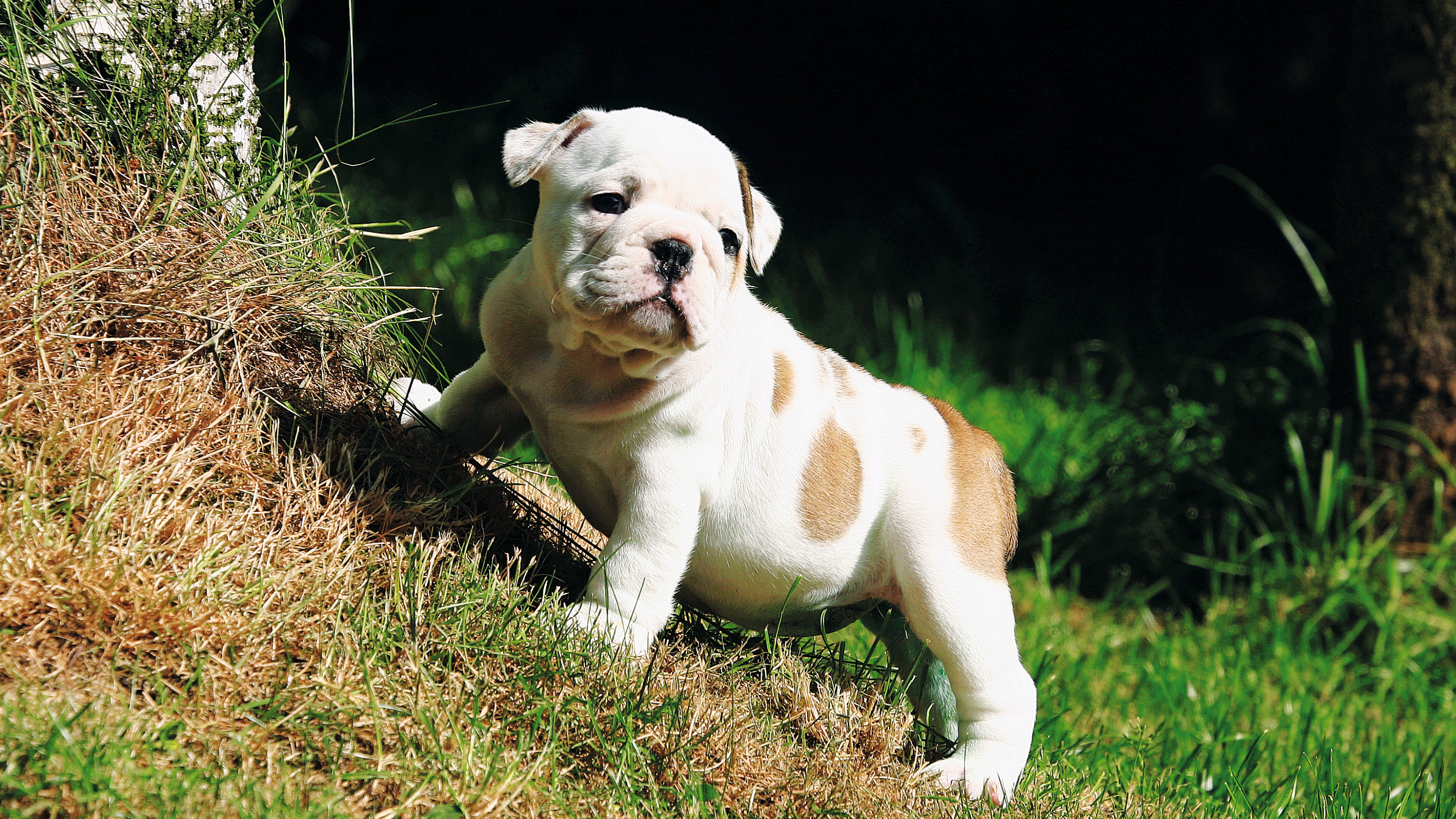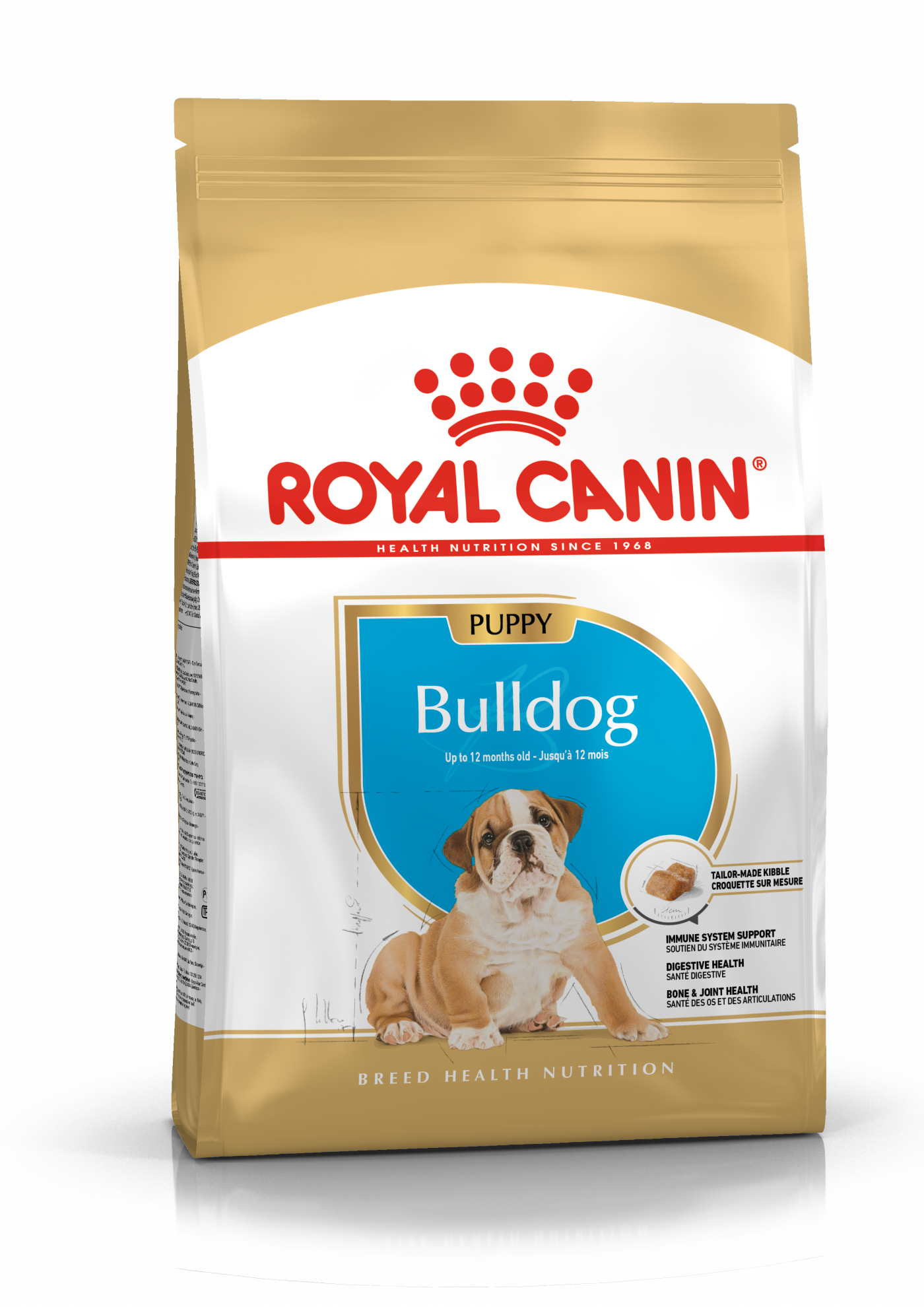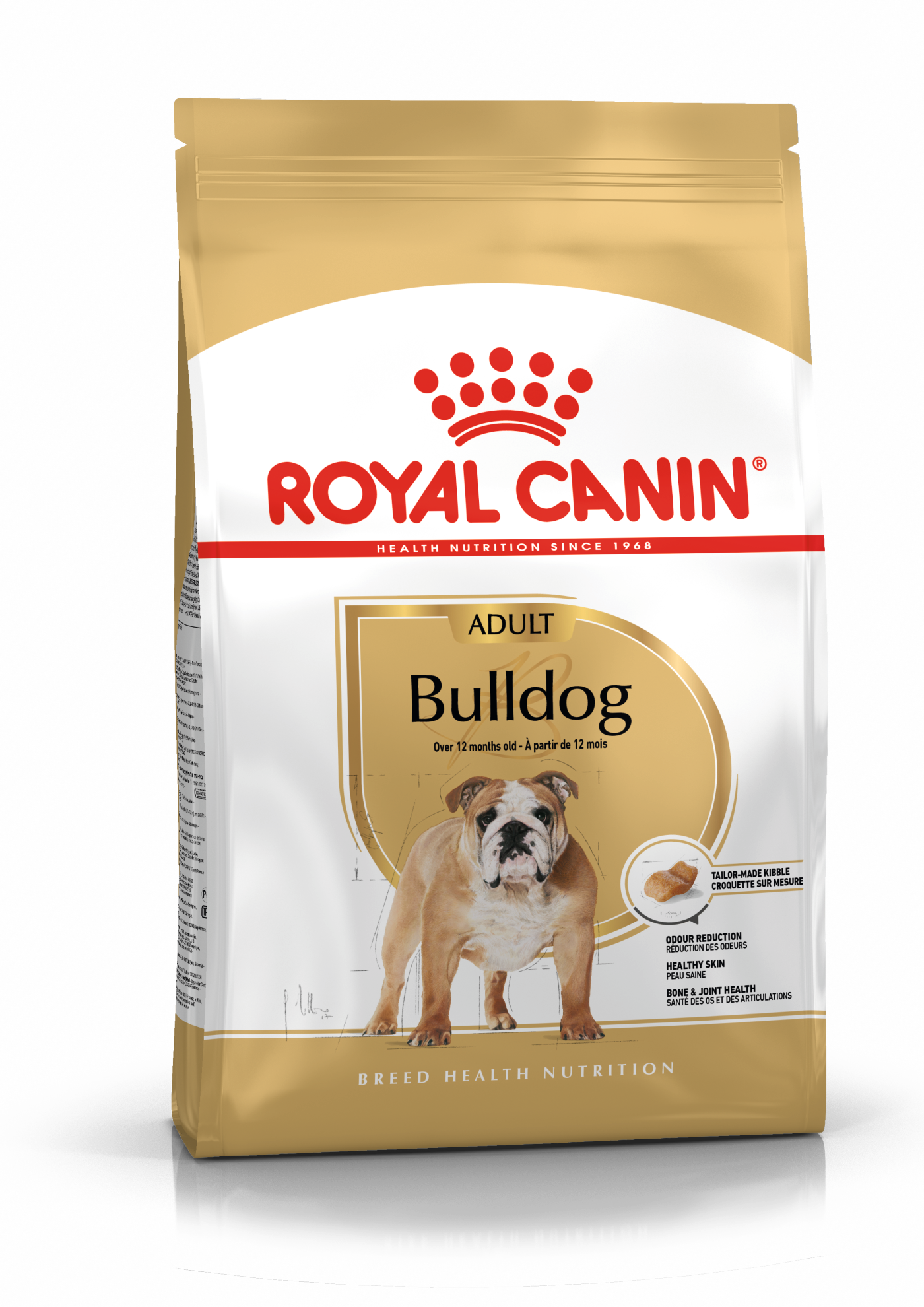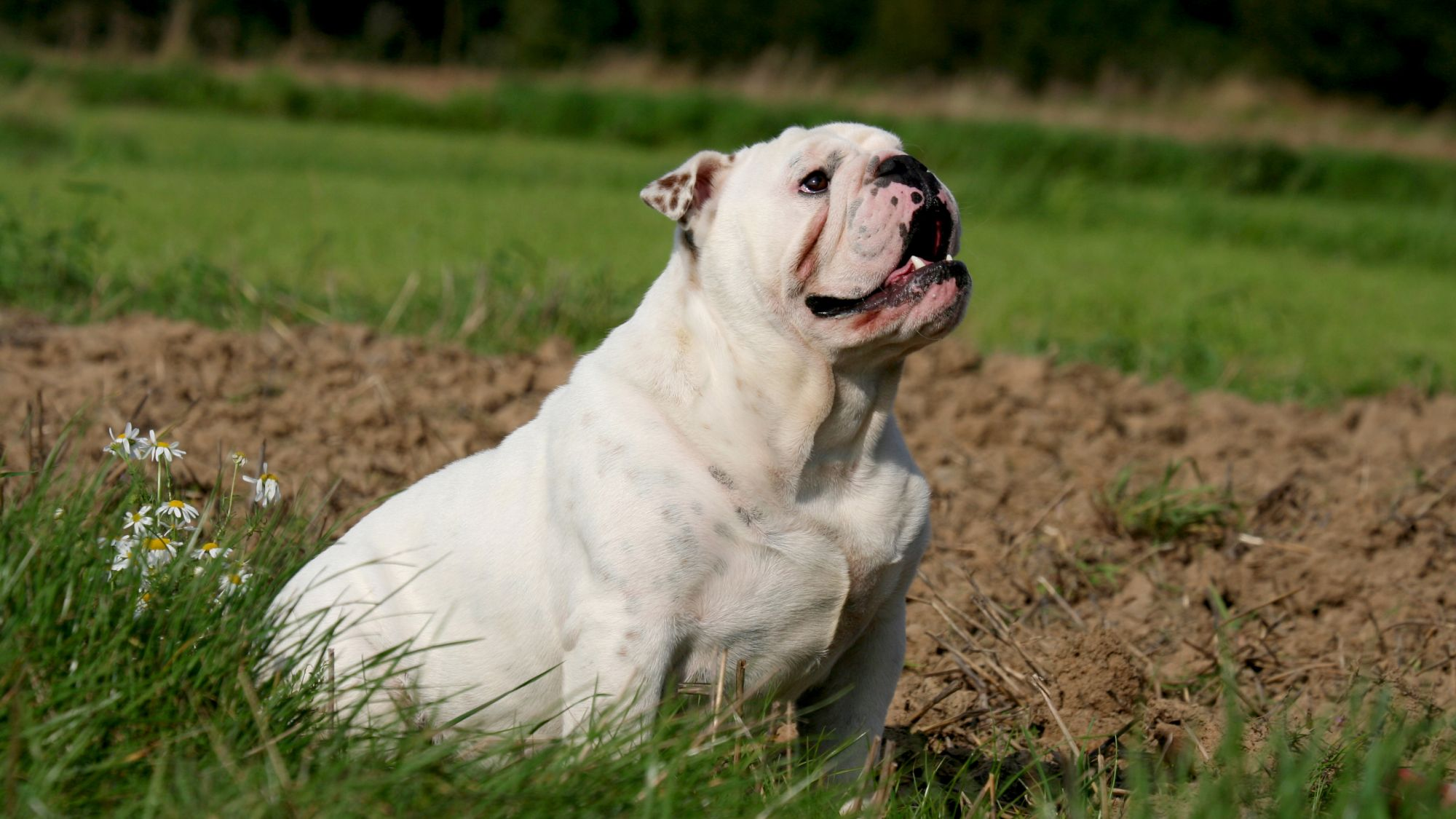Let's talk Bulldogs
Friendly, easy-going, and with a face that has won fans far and wide, the Bulldog is a cherished breed the world over. Their endearing overbite framed by chunky jowls and a hulking body is too much to resist. The Bulldog can weigh up to 25 kilograms yet his girth will always make him feel like more. Utilised in numerous advertisements and as a university mascot for their tough-as-nails look, the Bulldog is, in reality, a softie. Hanging at home - or anywhere his owner goes - suits him just fine.
Official name: Bulldog
Other names: English Bulldog, Old English Bulldog, British Bulldog
Origins: Britain
Drooling tendencies
5 out of 5Grooming needs
3 out of 5Shedding Level
3 out of 5Barking tendencies
4 out of 5Energy level*
1 out of 5Compatibility with other pets
5 out of 5Warm weather?
1 out of 5Cold weather?
1 out of 5Suited to apartment living
4 out of 5Can stay alone
1 out of 5Family pet?*
4 out of 5
| Male | Female |
|---|---|
| Height | Height |
| 36 - 38 cm | 66 - 69 cm |
| Weight | Weight |
| 25 - 30 kg | 23 - 25 kg |
| Life stages | |
|---|---|
| Puppy | Adult |
| 2 to 12 months | 1 to 7 years |
| Mature | Senior |
| 7 to 10 years | From 10 years |
| Baby | |
| Birth to 2 months | |
Drooling tendencies
5 out of 5Grooming needs
3 out of 5Shedding Level
3 out of 5Barking tendencies
4 out of 5Energy level*
1 out of 5Compatibility with other pets
5 out of 5Warm weather?
1 out of 5Cold weather?
1 out of 5Suited to apartment living
4 out of 5Can stay alone
1 out of 5Family pet?*
4 out of 5
| Male | Female |
|---|---|
| Height | Height |
| 36 - 38 cm | 66 - 69 cm |
| Weight | Weight |
| 25 - 30 kg | 23 - 25 kg |
| Life stages | |
|---|---|
| Puppy | Adult |
| 2 to 12 months | 1 to 7 years |
| Mature | Senior |
| 7 to 10 years | From 10 years |
| Baby | |
| Birth to 2 months | |

Get to know the Bulldog
All you need to know about the breed
Noble, docile, and a best friend for life, the Bulldog has too many winning attributes to mention. They’re a fantastic family dog with intense loyalty, and are easily pleased with the simplest gesture - and like to please in return. Contrary to what some may think, the Bulldog isn’t the least bit lazy; their heftier build comes from decades of breeding and an original use as a sporting dog. And body confidence is in, haven’t you heard?
Their coat too is a perennial favorite. It’s smooth and short-haired, and comes in the classic beige and white with patches of either white or black, with the occasional brindle thrown in for fun. And drumroll please… the Bulldog sheds very little.
Funny, Bulldogs look so tough but they are really a very sweet companion dog. One thing they will be grumpy about: scolding. So much so that they might ignore you for a bit if they feel it’s unjustified.
The Bulldog temperament is a courageous one, sometimes a little too much as they have a tendency to dominate other dogs. Not to worry: It just comes from being competitive. Bulldogs are super social with everyone in their midst, content with a few short walks each day. An exercise note: the Bulldog body is not good for longer sojourns nor swimming. Their stocky build will not maintain buoyancy and isn’t built for long distances.
The biggest health concern for the Bulldog breed surrounds correct breathing due to the flat construction of their face and nostrils. Known as a brachycephalic breed, their short muzzles and noses and undersized breathing passages mean too-hot or cold temperatures should be avoided. Cardiac problems, like arrhythmia or irregular heartbeats, can happen. Make routine vet visits to keep your Bulldog in check, and remember to acquire your Bulldog from a responsible breeder.
2 facts about Bulldogs
1. A charming face that requires care
Your Bulldogs’ chops, or the folds of skin around their face, are terribly charming but need to be wiped often to make sure moisture and even food aren’t trapped inside. Use a clean dry cloth to clean as often as possible.
2. When size might matter
Bullies are a hefty lot, a factor to consider if picking them up at home or loading them in and out of a car. Their dense body could be too much for one person. Pay close attention to their daily feeding to avoid undue weight gain.
History of the breed
The Bulldog breed can trace their legacy to 13th Century England and to the now-illegal sport of bullbaiting (thus the “Bull” in their name), when the breeds’ predecessors - more stout dogs with larger jaws - were used to wrestle a bull to the ground. Thankfully, England banned the sport in 1835.
Due to their long relationship with British culture, the breed is now almost considered a national icon. In the United States, the breed became cherished as well, and named the mascot of some notable institutions as a result of their seemingly tough demeanor: Yale University made the Bulldog a mascot for all sports teams, affectionately dubbing him, “Handsome Dan,” and the United States Marine Corps adopted the breed as their mascot after World War I. Breeders have continued to evolve the Bulldog temperament into the dog we know today, a true companion with an affable manner.
The Bulldog Club of America was established in 1890, and the breed has ranked in the American Kennel Club’s top five most popular breeds over the past seven years.
From head to tail
Physical characteristics of Bulldogs
1.Ears
2.Head
3.Body
4.Fur
5.Tail

Things to look out for
From specific breed traits to a general health overview, here are some interesting facts about your Bulldog
That flat face can be cause for concern
The Bulldogs’ most attractive feature might be their most hazardous: They are prone to respiratory problems due to their facial construction, which is called brachycephalic syndrome, one that’s characterised by a flattened snout and nostrils. Breathing difficulties - especially in hot or too - cold weather - can be common, or when their exercise session is too strenuous. Anaesthesia during surgery can also present problems with their flattened faces. Bulldogs do well in a space with proper ventilation and air conditioning where necessary.
Bulldogs do like to run. Just not far.
Despite their burly body, the Bulldog is one breed that enjoys agility training and has fun doing it. Don’t think that competition is reserved for the long-limbed canines of the world: the Bulldog’s competitive spirit means they’re always up for a good round of anything that tests their skill. The breed can run quickly, just not for long distances. Exercise is vital for any dog, and especially important for the Bulldog breed, one whose stocky body can top out at 50 pounds but still needs to stay fit and trim.
A breed with a tender heart
The Bulldog breedcan have a predisposition to arrhythmia, also known as an irregular heartbeat. Although the condition is rare, it can arise and could possibly result in fainting when not picked up on. Bulldogs are also predisposed to tetralogy of Fallot, a congenital (meaning present at birth) cardiac malformation. Making regular visits to the veterinarian to conduct a proper diagnosis of your Bulldog is important for starters, and the right treatment will help either condition, should they occur.
Healthy diet, healthier dog

When choosing food for a Bulldog, there are many factors to consider: their age, lifestyle, activity level, physical condition, and health including potential sickness or sensitivities. Food provides energy to cover a dog’s vital functions, and a complete nutritional formula should contain an adjusted balance of nutrients to avoid any deficiency or excess in their diet, both of which could have adverse effects on the dog. Clean and fresh water should be available at all times. In hot weather and especially when out exercising, bring water along for your dog’s frequent water breaks. Energy intake will always have to be adapted to the climatic conditions. A dog that lives outdoors in winter will have increased energy requirements. The following recommendations are for healthy animals. If your dog has health problems, please consult your veterinarian who will prescribe an exclusive veterinary diet.
A Bulldog puppy’s requirements, in terms of energy, protein, minerals, and vitamins, are much greater than those of an adult dog. They need energy and nutrients to maintain their body, but also to grow and build it. Until they are 12 months old, a Bulldog puppy’s immune system develops gradually. A complex of antioxidants - including vitamin E - can help support their natural defences during this time of big changes, discoveries, and new encounters. Their digestive functions are different from an adult Bulldog’s, too: their digestive system is not mature yet so it’s important to provide highly digestible proteins that will be effectively used. Prebiotics, such as fructo-oligosaccharides, support digestive health by helping balance the intestinal flora, resulting in good stool quality.
The brachycephalic nature of the Bulldog is an important factor that needs to be taken into account when choosing the size and shape of kibble to make it easier for them to pick up and to encourage chewing. Concentrations of other nutrients should be carefully adapted, especially the calcium and phosphorus content that supports the Bulldog puppy’s bones and joints. It is recommended to split the daily allowance into three meals until they are six months old, then to switch to two meals per day.

The main nutritional goals for adult Bulldog s are:
Promoting optimal digestibility with high quality protein and a balanced supply of dietary fibre, in order to reduce intestinal fermentation which may cause digestive disorders, flatulence, and bad stool odour
Maintaining healthy skin by strengthening the effectiveness of the skin barrier with the enriched addition of essential fatty acids (especially EPA-DHA), essential amino acids, and B vitamins.
Supporting healthy bones and joints thanks to chondroitin, glucosamine, and EPA-DHA.
Maintaining an ideal body weight by using highly digestible ingredients and keeping the fat content at a sensible level.
To help support their natural defences, a formula enriched with an antioxidant complex and containing mannan-oligosaccharides is recommended.

After 7 years old, Bulldogsstart facing the first signs of ageing. A formula enriched with antioxidants will help maintain their vitality, and specific nutrients, such as chondroitin, and glucosamine, will help maintain healthy bones and joints. Ageing is also accompanied by the modification of digestive capacities and particular nutritional requirements, so food for older Bulldogsshould have the following characteristics:
Higher vitamin C and E content. These nutrients have antioxidant properties, helping to protect the body’s cells against the harmful effects of the oxidative stress linked to ageing
High-quality protein. Contrary to a widely held misconception, lowering the protein content in food brings little benefit in limiting kidney failure. In addition, older dogs are less efficient at using dietary protein than younger dogs. Reducing the phosphorus content is a good way of slowing down the gradual deterioration of kidney function
A higher proportion of the trace elements iron, zinc, and manganese to maintain good condition of the skin and coat
A higher quantity of polyunsaturated fatty acids (borage oil, fish oil) to maintain the quality of the coat. Dogs normally produce these fatty acids, but ageing can affect this physiological process.
As they age, dogs increasingly suffer from teeth problems. To ensure they continue to eat in sufficient quantities, the shape, size and hardness of their kibble needs to be tailored to their jaw.

Caring for your Bulldog
Grooming, training and exercise tips
Moderate exercise is best for this breed. Make no mistake, they like to run and are very energetic, but not on a 5K. The breed cannot handle long distances as a result oftheir flattened faces and shortened snouts, which can make breathing difficult if they are put to the test too much. Quick spurts of play will be enough to tucker them out. Avoid exercising in weather that’s too hot or too cold as either can be potentially dangerous. And, for some reason, Bulldogs love skateboarding, and are really good at it!
Bulldog owners are in luck: the breed’s short hair commands no more than a 10-minute brushing with a soft brush a few times a week. Bulldogs are known for those fetching wrinkles around their face and upper body -especially around the tail - however moisture can become trapped there, or even food in the facial area. Clean within the folds with a damp cloth followed by a clean dry one to absorb moisture. Avoid the eye area, please! Bulldogs are prone to pododermatitis, inflammation of the skin and the paw. Make sure the feet are also kept clean and dry.
Obedient but reserved, the Bulldog enjoys human companionship but needs a gentle approach when it comes to discipline. They are an intelligent breed but can be vulnerable at times, especially when reprimanded too strongly. Satisfy their attention-seeking streak with affirmation and positive reinforcement.
Moderate exercise is best for this breed. Make no mistake, they like to run and are very energetic, but not on a 5K. The breed cannot handle long distances as a result oftheir flattened faces and shortened snouts, which can make breathing difficult if they are put to the test too much. Quick spurts of play will be enough to tucker them out. Avoid exercising in weather that’s too hot or too cold as either can be potentially dangerous. And, for some reason, Bulldogs love skateboarding, and are really good at it!
Bulldog owners are in luck: the breed’s short hair commands no more than a 10-minute brushing with a soft brush a few times a week. Bulldogs are known for those fetching wrinkles around their face and upper body -especially around the tail - however moisture can become trapped there, or even food in the facial area. Clean within the folds with a damp cloth followed by a clean dry one to absorb moisture. Avoid the eye area, please! Bulldogs are prone to pododermatitis, inflammation of the skin and the paw. Make sure the feet are also kept clean and dry.
Obedient but reserved, the Bulldog enjoys human companionship but needs a gentle approach when it comes to discipline. They are an intelligent breed but can be vulnerable at times, especially when reprimanded too strongly. Satisfy their attention-seeking streak with affirmation and positive reinforcement.
7/7
All about Bulldogs
Although they’ve got a tough look about them, it’s merely that: the Bulldog has a friendly demeanor and doesn’t tend to be threatening. Their use in the aggressive sport of bull-baiting was outlawed over 100 years ago, thankfully. The breed is now an endearing companion.
This incredibly easy-going breed is treasured by families and singles alike, valued for their affable manner and upbeat personality. The Bulldog temperament is a great one, making for a fabulous companion dog as they are calm and affectionate. The one concern for owners are any health problems that could arise from their more flattened snouts, which can potentially cause breathing problems. We recommend always acquiring your dog from a responsible breeder.
Other breeds that might interest you
Read more on this topic
Sources
- Veterinary Centers of America https://vcahospitals.com/
- Royal Canin Dog Encyclopaedia. Ed 2010 and 2020
- Banfield Pet Hospital https://www.banfield.com/
- Royal Canin BHN Product Book
- American Kennel Club https://www.akc.org/
Like & share this page